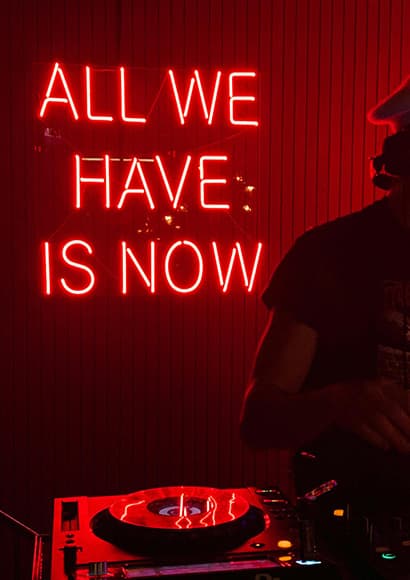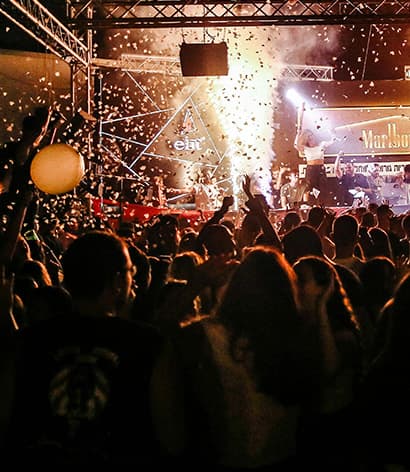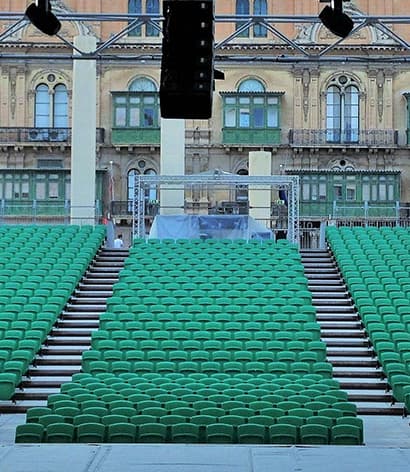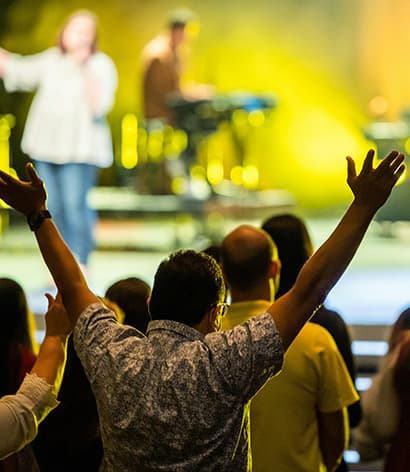Live Event Data
Collection Software
You’ve heard it said many times: knowledge is power. In the realm of event management, knowledge applies to guest demographic and attendance data gathering and insights into the operations of a live event.
When technology is constantly advancing, it is critical for event managers to harness the power of data collection to help understand attendee behavior, define your target audience, and develop new strategies to improve each live event your company hosts.
However, the amount of data you are most likely neglecting to collect is vast. Where do you begin? How do you know which data to track and which can be ignored? And how do you go about collecting data at a live event?
Here’s an easy answer to the last one for you: your brand needs live event data collection software. When you utilize a tool that can gather the data for you — ideally a comprehensive software like we provide at In The Room — all that’s left for you to do is analyze and interpret that data to help create new strategies for improvement.
What Is Live Event Data Collection Software?
Data collection software for live events does just what the name suggests. Event data collection software is crucial for live event management. It’s virtually impossible to track every piece of data that you should be collecting manually, on pieces of paper. And in order to ascertain the success rates of every session, talk, performance, or lecture at your event, you’ll need to collect all the data available.
Data collection software makes things more convenient because it can digitally collect and store live event data; it also allows you to easily transfer that data to be easily analyzed. Once you’ve analyzed all of the important data, usually through an integrated event analytics software program, you will be able to use those analytics to gain insight into the success of your live event.
Though you should still send post-event surveys to all attendees, data collection software can help you get a feel for which sessions your guests preferred, their behavior during the event, and how each session, talk, or performance measured up to their expectations.

Why Should I Use Data Collection and Analytics Software?
Sure, getting insights into the success of your live event sounds great. But do you really need it?
The answer to that question is yes. Without detailed guest attendance, demographic, and behavioral information, you will have a harder time knowing which areas to improve upon before the next one.
By learning more about your guests, you will be able to provide more of the topics, speakers, sessions, and even food choices that most resonated with them. Likewise, by discovering which parts of your event were successful and which were not, you will be able to add more engaging elements and build on the parts that needed work.
Which Pieces of Data Should I Track?
So, you now know that if you want your next live event to be a hit with your audience, you’ll need to employ live event data collection at each one. From here you’ll need to decide which pieces of data are most helpful to you and which you don’t need to worry about.
First: Define Your Goals
Before you decide on the important metrics to gather, you should define your live event goals. When you do this, you will need to be very specific in how you think about each of your objectives.
For example, “I want to sell a lot of my company’s products” is not a specific enough event goal. “I want to sell X number of products during the next live event” and “I will aim to bring in X number of dollars in revenue during the next event,” however, are much more definable goals.
Each goal set needs to be concrete, realistically attainable, and measurable to be able to determine the success of your live event.
Objectives for events can vary widely. Here are some examples of goals you might want to consider for your next live event:
- Bring in over 1,000 attendees to help raise brand or product awareness
- Increase registrant engagement on your company website by 30% by the end of the event
- Increase ticket sales by 15% compared to the sales from last year’s event
- Teach 10 workshops to company attendees to help standardize company policies
Not all of these example goals will apply to your event. For example, let’s say you represent a company that employs music teachers that instruct children on the music courses your company has created for distribution. In this case, your company may hold two very different kinds of live events: one where you invite the public to learn about your music courses, and another where you teach workshops to your contracted music teachers.

For the first kind of event, the first three goals might align well with your live event’s purpose. The last goal, however, would only be appropriate for an event where the music teachers, not the general public, are invited.
Your specific event goals will all depend on the nature and structure of your company, brand, or live event. You should also consider the specific ways you are looking to grow your brand, increase product or ticket sales, and build the public’s trust in your company.
Once you’ve defined your specific live event goals, it’s time to consider the metrics you would like to use to help gather data while it is going on.
Marketing Traffic Sources
Potential attendees will need to find out about your event somehow. Whether your marketing strategy includes email newsletters, organic search, social media platform posts, or word of mouth marketing, you should also choose a data collection method that can report back to you about where your registrants have learned about your live event.
With access to this sourcing and identifying data, you can examine how effectively your marketing strategies are being employed. If one of your goals is to increase guest attendance at your next live event, you will be able to use these metrics to adjust the marketing strategy and advertise your event to the ideal audiences.
Traffic Behaviors
Analyzing the behavior of your online and email traffic involves looking at how potential event registrants interact with your created marketing content. Some examples of traffic behaviors include:
- The open rates of marketing emails
- Click-through rates of online advertisements
- Average time spent on your landing page
- The sales and upsell rates through all channels
That last data point, sales and upsell rates, is especially important to compare with each of the other points listed.
For example, you may have met your goal for ticket sales. But if less than 1% of landing page visitors make a purchase, and you are showing low open and click-through rates on ads, you may want to adjust your marketing tactics to help improve those conversions.

Upsell Rates
Many of your event guests will register as VIPs during the initial registration process. Several more may want to add VIP status to their tickets during event check-in. Both of these numbers are useful metrics to track to be able to examine how successful your upsell strategy is.
Some questions you should consider when looking at VIP upsell rates:
- Is the VIP upgrade priced correctly?
- Do my event’s VIP perks offer enough to justify the added price?
- Am I showcasing these perks effectively?
- Is the upsell process easy for all registrants?
If it’s too complicated for registrants to upgrade to VIP status, they’ll abandon the effort, and you’ll lose out on additional revenue. Ensure your software provides one-click upsells to make it a quick and effortless experience. (Hint: In The Room’s software does this flawlessly and is guaranteed to get you more upsell conversions.)
Attendee Feedback
There’s no better way to understand your guests’ preferences than to ask them. After any live event, you should be sending out surveys to your guests, asking them detailed questions on what they thought of your event. You can ask them for feedback on specific sessions, speakers, activities, the venue space, and more.
However, you’ll need to be strategic when doing this. The last thing you want to do is send out cheerful surveys to registrants who are disappointed that they couldn’t make it. On the other hand, consider how appreciated guests will feel if you send them personalized follow-up surveys asking only about the sessions and activities you know they attended.
This is why it is so important to use live event data capture programs to help you integrate this data tracking with your email marketing strategy. Keep track of who is “In The Room” at every session, lecture, and performance. With software from In The Room, you’ll only need to ask guests the most relevant questions, showing them that you’re not interested in wasting their time.

Registrant Profiles and Demographics
Gathering demographic profiles on all of your registrants is a vital element of data to track. Profile information can include the registrant’s name, age, gender, contact information, job title, company, industry, and more.
With all of this information, you will be able to tailor both your marketing strategy and your event’s content. For example, if many of your registrants are entrepreneurs in the 25–50-year age group, you will be able to aim marketing efforts specifically toward that group of people.
Profile demographic information also allows you to seek out well-known speakers specific to session topics and activities that would interest your target audience.
Event Attendance and Drop-Off Rates
This is a big one. Regardless of your event type and specific goals, you will want to track your live event’s attendance numbers, and you should do it using advanced live event data tracking.
Here’s what we mean by that. Nearly all event managers track their overall event attendance. But not as many track exact attendance numbers for every session within the event. Even fewer record the drop-off rates of each session. Drop-off rates show which guests leave a session before it is over.
Gathering data on session attendance numbers show you which sessions were the most popular with your guests. Collecting the drop-off data will show you which sessions fell flat with attendees.
If one session had a high attendance rate but a high drop-off rate, it probably didn’t meet guests’ expectations. Conversely, if a session had a low attendance rate and a proportionately low drop-off rate, you probably could have advertised that session more heavily (and should do so in the future).

Pack a Punch with In The Room’s Data Collection Software
When you combine your attendance data with attendee profiles, you’ll be able to see exactly what kind of people attended — and stayed for the entirety of — each session. Doing this is an incredibly effective way to evaluate your live event as a whole. It will also help you adjust your marketing strategies to ensure information for your next event reaches as many interested people as possible.
Very few data collection software programs will provide you with all the necessary information your brand needs. In fact, the reason In The Room exists is because we couldn’t find anyone with the technology to collect and analyze live event data the way we knew it needed to be done. So we built it ourselves.
That’s just one of the many reasons why choosing In The Room for live event data collection software is the best choice you can make when planning your next event. With our finely tuned data tracking and sophisticated analytics software, you’ll obtain powerful new insights into what your attendees want from your event.
Additionally, In The Room’s data analytics will help you gather and interpret all of your event metrics. You’ll see what’s going well and what needs improvement. Using analyzed data, you will be able to tweak your marketing strategies to meet all your live event goals more efficiently. We even offer one-on-one expert mentoring to help you optimize and monetize every aspect of the event.
It’s an easy choice: with In The Room’s data collection software, you’ll meet every goal you set for your event and ensure that your guests have an optimal experience.
